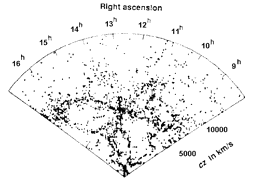 |
Science Frontiers ONLINE No. 67: Jan-Feb 1990 |
|
|
Astronomers up against the "great wall"
"For more than a decade now, astronomers have been haunted by a sense that the universe is controlled by forces they don't understand. And now comes a striking confirmation: 'The Great Wall.'"
The Great Wall is the largest known structure in the universe at present, having superceded sundry superclusters and clusters of superclusters. The Wall is a "thin" (15 million-light-year) sheet of galaxies 500 million light years long by 200 wide; and it may extend even farther. It is emplaced some 200-300 million light years from earth. It helps outline contiguaous parts of vast "bubbles" of nearly empty space. Both the Wall and the adjacent voids are just too large for current theories to deal with. All popular theories have great difficulties in accounting for such large inhomogeneities. To illustrate an important observable -- the 2.7�K cosmic background radiation -- which is usually described as the afterglow of the Big Bang, ar gues for a very smooth, uniform distribution of galaxies. Great Walls are definitely anomalous.
M.J. Geller, codiscoverer of the Great Wall with J.P. Huchra, remarked:
"My view is that there is something fundamentally wrong in our approach to understanding such large-scale structure -- some key piece of the puzzle that we're missing."
(Waldrop, M. Mitchell; "Astronomers Go Up against the Great Wall," Science, 246:885, 1989.) Also: Geller, Margaret J., and Huchra, John P.; "Mapping the Universe," Science, 246:897, 1989. And: McKenzie, A.; "Cosmic Cartographers Find 'Great Wall,'" Science News, 136:340, 1989.)
The discovery of the Great Wall of galaxies and the regular clumping of galactic matter has greatly surprised astronomers, who have been emphasizing how uniformly distributed galactic matter should -- according to theory, at least. Now, D.C. Koo, at the University of California at Santa Cruz, says, "The regularity is just mind-boggling." M. Davis, an astrophysicist at Berkeley, admits that if the distribution of galaxies is truly so regular, "...it is safe to say we understand less than zero about the early universe." (Wilford, John Noble; "Unexpected Order in Universe Confuses Scientists," Pittsburgh Post Gazette, May 28, 1990. Cr. E.D.Fegert)
Reference. Chapter AWB in our catalog: Stars, Galaxies, Cosmos deals with the large-scale structure of the universe. Book description here.
 | Cone diagram for 2500 galaxies betweeen declinations 26.5 and 44.5�. The Great Wall runs across the survey. (From: M.J. Geller and J.P. Huchra) |